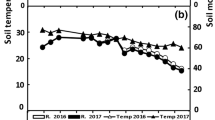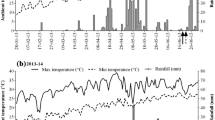Abstract
Methane (CH4) and nitrous oxide (N2O) are two important greenhouse gases (GHG) and contribute largely to global warming and climate change. The impact of physiological characteristics of rice genotypes on global warming potential (GWP) and greenhouse gas intensity (GHGI) is not well documented. A 2-year field experiment was conducted with eight summer rice varieties: Dinanath, Joymoti, Kanaklata, Swarnabh, IR 64, Tapaswami (modern varieties), Number 9, and Jagilee Boro (indigenous varieties) for two successive seasons (December–June, 2015–2016 and December–June, 2016–2017) to estimate their GWP and GHGI. The GWP of the rice varieties ranged from 841.52 to 1288.67 kg CO2-equiv. ha−1 and GHGI from 0.184 to 0.854 kg CO2-equiv. kg−1 grain yield. Significant differences (p < 0.05) in seasonal GHG emission, GWP, GHGI, CEE (carbon equivalent emission), photosynthetic efficiency, stomatal conductance, transpiration rate, and grain productivity among the rice varieties were observed during the investigation. A good correlation of GWP (p < 0.01) was recorded with rate of stomatal conductance and transpiration rate of the varieties. The present study reveals a strong relationship between plant biomass (p < 0.01) with GWP and CEE of the rice varieties. The variety IR 64 and Number 9 are identified as the most suitable variety with lowest GWP (909.85 and 876.68 kg CO2-equiv. ha−1 respectively) and GHGI (0.192 and 0.227 kg CO2-equiv. kg−1 grain yield respectively) accompanied by higher grain productivity (4839 and 3867 kg ha−1 respectively). Observations from the study suggest that agricultural productivity and GHG mitigation can be simultaneously achieved by proper selection of rice genotypes.




Similar content being viewed by others
References
Baruah KK, Gogoi B, Gogoi P (2010) Plant physiological and soil characteristics associated with methane and nitrous oxide emission from rice paddy. Physiol Mol Biol Plants 16:79–91
Baruah KK, Gogoi B, Borah L, Gogoi M, Boruah R (2012) Plant morphophysiological and anatomical factors associated with nitrous oxide flux from wheat (Triticum aestivum). J Plant Res 125:507–516
Baruah A, Baruah KK, Gorh D, Gupta P (2016a) Effect of organic residues with varied carbon – nitrogen ratio on grain yield, soil health and nitrous oxide emission from a rice agroecosystem. Commun Soil Sci Plant Anal 47:1417–1429
Baruah A, Baruah KK, Bhattacharya P (2016b) Comparative effectiveness of organic substitution in fertilizer schedule: impacts on nitrous oxide emission, photosynthesis, and crop productivity in a tropical summer rice paddy. Water Air Soil Pollut 227:410–423
Berger S, Jang I, Seo J, Kang H, Gebauer G (2013) A record of N2O and CH4 emissions and underlying soil processes of Korean rice paddies as affected by different water management practices. Biogeochemistry 115:317–332
Bharali A, Baruah KK, Gogoi N (2017a) Methane emission from irrigated rice ecosystem: relationship with carbon fixation, partitioning and soil carbon storage. Paddy Water Environ 15:221–236
Bharali A, Baruah KK, Gogoi N (2017b) Potential option for mitigating methane emission from tropical paddy rice through selection of suitable rice varieties. Crop and Pasture Science 68:421–433
Bhatia A, Sasmal S, Jain N, Pathak H, Kumar R, Singh A (2010) Mitigating nitrous oxide emissions from soils under conventional and no tillage in wheat using nitrification inhibitors. Agric Ecosyst Environ 136:247–253
Borah L, Baruah KK (2016a) Nitrous oxide emission and mitigation from wheat agriculture: association of physiological and anatomical characteristics of wheat genotypes. Environ Sci Pollut Res 23:709–721
Borah L, Baruah KK (2016b) Effects of foliar application of plant growth hormone on methane emission from tropical rice paddy. Agric Ecosyst Environ 233:75–84
Bordoloi N, Baruah KK, Maji TK (2016) Nitrous oxide emission from transplanted rice field in alluvial soil as influenced by management of nitrogen fertilizer. Soil Use Manag 32:573–582
Bordoloi N, Baruah KK, Thakur AJ (2018) Effectiveness of plant growth regulators on emission reduction of greenhouse gas (nitrous oxide): an approach for cleaner environment. J Clean Prod 171:333–344
Carew R, Smith EG, Grant C (2009) Factors influencing wheat yield and variability: evidence from Manitoba, Canada. J Agric Appl Econ 41:625–639
Central Rice Research Institute (CRRI) - Indian Council of Agricultural Research.(n.d.) Cuttack (Odisha). –VISION 2050. http://www.crri.nic.in/ebookcrrivision 2050_final_16Jan13.pdf. Accessed 16 Jan 2013
Chawanakul S, Chaiprasert P, Towprayoon S, Tanticharoen M (2009) Contributions of available substrates and activities of trophic microbial community to methanogenesis in vegetative and reproductive rice rhizospheric soil. J Environ Biol 30:119–127
Das S, Adhya TK (2014) Effect of combine application of organic manure and inorganic fertilizer on methane and nitrous oxide emissions from a tropical flooded soil planted to rice. Geoderma 213:185–192
Das K, Baruah KK (2008a) A comparison of growth and photosynthetic characteristics of two improved rice cultivars on methane emission from rain fed agro ecosystem of northeast India. Agric Ecosyst Environ 124(12):105–113
Del Grosso SJ, Parton WJ, Mosier AR et al (2000) General model for N2O and N2 gas emissions from soils due to dentrification. Glob Biogeochem Cycles 14:1045–1060
Directorate of Rice Development (DRD) (2014) Chapter 4. directorate of rice development, Status paper on rice. . Government of India, Ministry of Agriculture & Farmer's Welfare, Patna
Feng J, Chen C, Zhang Y, Song Z, Deng A, Zheng C, Zhang W (2013) Impacts of cropping practices on yield-scaled greenhouse gas emissions from rice fields in China: a meta-analysis. Agric Ecosyst Environ 164:220–228
Gupta DK, Bhatia A, Kumar A et al (2015) Global warming potential of rice (Oryza sativa)-wheat (Triticum aestivum) cropping system of the Indo-Gangetic Plains. Indian J Agric Sci 85:807–816
Henry S, Texier S, Hallet S, Bru D, Dambreville C, Chèneby D, Bizouard F, Germon JC, Philippot L (2008) Disentangling the rhizosphere effect on nitrate reducers and denitrifiers: insight into the role of root exudates. Environ Microbiol 10:3082–3092
Hirasawa T, Ozawa S, Taylaran RD, Ookawa T (2010) Varietal differences in photosynthetic rates in rice plants, with special reference to the nitrogen content of leaves. Plant Prod Sci 13:53–57
Hussain S, Peng S, Fahad S, Khaliq A, Huang J, Cui K, Nie L (2015) Rice management interventions to mitigate greenhouse gas emissions: a review. Environ Sci Pollut Res 22:3342–3360
Intergovernment panel on climate change (IPCC) 2013 fifth assessment report (AR5) contribution of working group III to climate change 2014: Mitigation of Climate Change
Jain N, Dubey R, Dubey DS, Singh J, Khanna M, Pathak H, Bhatia A (2014) Mitigation of greenhouse gas emission with system of rice intensification in the Indo-Gangetic Plains. Paddy Water Environ 12:355–363
Jiang Y, Huang X, Zhang X, Zhang X, Zhang Y, Zheng C, Deng A, Zhang J, Wu L, Hu S, Zhang W (2016) Optimizing rice plant photosynthate allocation reduces N2O emissions from paddy fields. Sci Report 6:29333. https://doi.org/10.1038/srep29333
Kell DB (2012) Large-scale sequestration of atmospheric carbon via plant roots in natural and agricultural ecosystems: why and how. Philos Trans R Soc B 367:1589–1597
Lin S, Iqbal J, Hu R, Feng M (2010) N20 emission from different land uses in mid-subtropical China. Agric Ecosyst Environ 136:40–48
Linquist BA, Arlene M, Borbe A et al (2012) Fertilizer management practices and greenhouse gas emissions from rice systems: a quantitative review and analysis. Field Crop Res 135:10–21
Ma J, Ma E, Xu H, Yagi K, Cai Z (2009) Wheat straw management affects CH4 and N2O emissions from rice fields. Soil Biol Biochem 41:1022–1028
Moldenhauer K, Wilson CE, Counce P, Jr Hardke J (2013) Rice growth and development. In: Hardke, J.T. (Eds) Arkansas rice production handbook. University of Arkansas Division of Agriculture, Cooperative Extension Service: Little Rock, AR, USA, 9–20
Mosier AR, Halvorson AD, Reule CA, Liu XJ (2006) Net global warming potential and greenhouse gas intensity in irrigated cropping systems in Northeastern Colorado. J Environ Qual 35:1584–1598
Motwani DN, Mehta P (2018) Effect of veterinary antibiotics on the seed germination of indica rice varieties. Annals of Plant Sciences 7:2321–2327
Nuccio ML, Potter L, Stiegelmeyer SM, Curley J, Cohn J, Wittich PE, Tan X, Davis J, Ni J, Trullinger J, Hall R, Bate NJ (2017) Strategies and tools to improve crop productivity by targeting photosynthesis. Philos Trans R Soc B 372:20160377 https://doi.org/10.1098/rstb.2016.0377
Page AL, Miller RH, Keeney DR (1982) Methods of soil analysis, part 2, chemical and microbiological properties. 2nd ed. Agronomy No. 9, ASA-SSSA, Madison, WI, USA
Pangala SR, Gowing DJ, Hornibrook ERC, Gauci V (2014) Controls on methane emissions from Alnus glutinosa saplings. New Phytol 201:887–896
Parashar DC, Mitra AP, Gupta PK, Rai J, Sharma RC, Singh N, Koul S, Ray HS, Das SN, Parida KM, Rao SB, Kanungo SP, Ramasami T, Nair BU, Swamy M, Singh G, Gupta SK, Singh AR, Saikia BK, Batua AKS, Pathak MG, Iyer CSP, Gopalakrishnan M, Sane PV, Singh SN, Banerjee R, Sethunathan N, Adhya TK, Rao VR, Palit P, Saha AK, Purkait NN, Chaturvedi GS, Sen SP, Sen M, Sarkar B, Banik A, Subbaraya BH, Lal S, Venkatramani S, Lal G, Chaudhary A, Sinha SK (1996) Methane budget from paddy fields in India. Chemosphere 33:737–757
Ray DK, Muellet ND, West PC, Foley JA (2013) Yield trends are insufficient to double global crop production by 2050. PLoS One 8:e66428. https://doi.org/10.1371/journal.pone.0066428
Robertson GP, Grace PR (2004) Greenhouse gas fluxes in tropical and temperate agriculture: the need for a full-cost accounting of global warming potentials. Environ Dev Sustain 6:51–63
Savitha P, Ushakumari R (2016) Indigenous knowledge of traditional landraces in rice (Oryza sativa L.) in situ conservation of Tamil Nadu, India. Indian J Trad Knowledge 15:321–329
Shang Q, Yang X, Gao C et al (2011) Net annual global warming potential and greenhouse gas intensity in Chinese double rice-cropping systems: a 3-year field measurement in long-term fertilizer experiments. Glob Chang Biol 17:2196–2210
Sharma SK, Chauhan R (2011) Climate change research initiative: Indian network for climate change assessment. Curr Sci 101:308–311
Smith P, Martino D, Cai Z, Gwary D, Janzen H, Kumar P, McCarl B, Ogle S, O'Mara F, Rice C, Scholes B, Sirotenko O, Howden M, McAllister T, Pan G, Romanenkov V, Schneider U, Towprayoon S, Wattenbach M, Smith J (2008) Greenhouse gas mitigation in agriculture. Philos Trans R Soc B 363:789–813
Suryavanshi P, Singh YV, Prasanna R, Bhatia A, Shivay YS (2013) Pattern of methane emission and water productivity under different methods of rice crop establishment. Paddy Water Environ 11:321–329
Sutka RL, Ostrom NE, Ostrom PH, Breznak JA, Gandhi H, Pitt AJ, Li F (2006) Distinguishing nitrous oxide production from nitrification and denitrification on the basis of isotopomer abundances. Appl Environ Microbiol 72:638–644
Wang B, Adachi K (2000) Differences among rice cultivars in root exudation, methane oxidation, and populations of methanogenic and methanotrophic bacteria in relation to methane emission. Nutr Cycl Agroecosyst 58:349–356
Wang JY, Jia JX, Xiong ZQ, Khalil MAK, Xing GX (2011) Water regime- nitrogen fertilizer-straw incorporation interaction: field study on nitrous oxide emission from a rice agroecosystem in Nanjing, China. Agric Ecosyst Environ 141:437–446
Wang W, Lai DYF, Sardans J, Wang C, Datta A, Pan T, Zeng C, Bartrons M, Peñuelas J (2015) Rice straw incorporation affects global warming potential differently in early vs. late cropping seasons in southeastern China. Field Crop Res 181:42–51
Wassmann R, Alberto MC, Tirol-Padre A, Hoang NT, Romasanta R, Centeno CA, Sander BO (2018) Increasing sensitivity of methane emission measurements in rice through deployment of “close chambers” at nighttime. PLoS One 13:e0191352. https://doi.org/10.1371/journal.pone.0191352
World Meteorological Organization (WMO) (2017) The state of greenhouse gases in the atmosphere based on global observations through 2016. Greenh. Gas Bull 1–8
Zhan M, Cao C, Wang J, Jiang Y, Cai M, Yue L, Shahrear A (2011) Dynamics of methane emission, active oil organic carbon and their relationships in wetland integrated rice-duck systems in southern China. Nutr Cycl Agroecosyst 89:1–13
Funding
Dipti Gorh is grateful to Tezpur University, for providing financial support to carry out the present research in the form of Institutional fellowship.
Author information
Authors and Affiliations
Corresponding author
Additional information
Responsible editor: Philippe Garrigues
Publisher’s note
Springer Nature remains neutral with regard to jurisdictional claims in published maps and institutional affiliations.
Electronic supplementary material
ESM 1
(DOCX 12 kb)
Rights and permissions
About this article
Cite this article
Gorh, D., Baruah, K.K. Estimation of methane and nitrous oxide emission from wetland rice paddies with reference to global warming potential. Environ Sci Pollut Res 26, 16331–16344 (2019). https://doi.org/10.1007/s11356-019-05026-z
Received:
Accepted:
Published:
Issue Date:
DOI: https://doi.org/10.1007/s11356-019-05026-z




